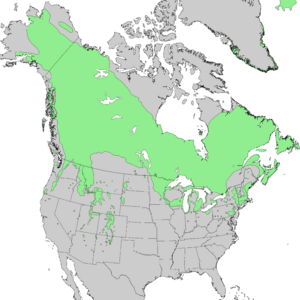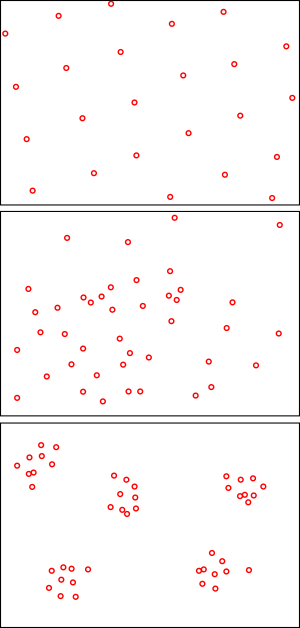Species distribution facts for kids

Species distribution is how living things are spread out in an area. It's also called species dispersion. Think of it as a map showing where a certain type of animal or plant lives. The total area where a species can be found is called its range. This is often shown as shaded areas on a map.
How species are spread out can look different depending on how closely you look. It could be how a small family group is arranged, or how a whole group of animals (a population) is spread, or even where an entire species lives across the world. Species distribution is different from dispersal, which is about how individuals move away from where they started or from crowded areas.
Contents
Range: Where Species Live
In biology, the range of a species is the area on Earth where you can find that species. Within that range, distribution describes the general way the species' population is spread out. Dispersion is about how crowded or spread out the individuals are within that area.
Here are some ways we describe a species' range:
- Native range: This is the area where a species naturally started and has lived for a very long time.
- Introduced range: This is a new area where a species has started living, usually because humans moved them there. This can happen on purpose or by accident. When a species is moved by humans across a big barrier, like an ocean, we call it introduced.
- Summer range and winter range: Some species, especially those that migrate, live in different places during different seasons.
- Breeding range and non-breeding range: For animals that only use part of their range to have babies, these terms describe where they breed and where they don't.
- Natural range: This term is often used for animals that move around a lot. It means the places they usually live, not just places they visit by accident.
- We can also add details like British range or pre-1950 range to show a specific place or time. Ranges can also be described by how far north or south they go (latitudinal range) or how high up they live (elevational range).
Sometimes, a species' range can be split into two or more areas that are far apart. This is called a disjunct distribution.
What Affects Where Species Live?
The way species are spread out can change. This can be due to seasons, human actions, how much food or water is available, and other things in their environment. These factors are split into two main types: abiotic and biotic.
Abiotic Factors (Non-Living Things)
Abiotic factors are non-living parts of the environment that affect living things. There are three main types:
- Climatic factors: These include things like sunlight, air, humidity, temperature, and how salty the water is.
- Edaphic factors: These are about the soil. They include how coarse the soil is, the type of rocks nearby, the soil pH (how acidic or basic the soil is), and how much air is in the soil.
- Social factors: These include how land is used by humans and how much water is available.
For example, in dry areas, many animals will gather around water sources. This makes them form a "clumped" group.
Scientists studying the Arctic Ocean have seen more warm-water crabs in the seas around Norway. This shows that as ocean temperatures rise due to climate change, species are starting to move into colder Arctic waters. Even the snow crab has moved its range 500 kilometers north!
Biotic Factors (Living Things)
Biotic factors are living parts of the environment that affect other living things. These include things like:
- Predation: When one animal hunts another for food.
- Disease: Illnesses that can spread through a population.
- Competition: When different species, or even individuals of the same species, fight for resources like food, water, or mates.
For instance, a quail's biotic factors would include the insects and seeds it eats, other quails it competes with, and predators like coyotes. Living in a group can help animals spot predators sooner and defend themselves better. On the other hand, if resources are limited, species might spread out evenly to reduce competition, like trees in a forest competing for sunlight.
Humans are a big reason why species are spread out in new ways. This is because of globalization and the growth of the transportation industry. For example, large ships often fill their ballast tanks with water in one port and empty it in another. This can accidentally move aquatic species to new places, spreading them wider.
How Species Are Spread on Large Areas
When you look at a very large area, species often appear to be grouped together, or "clumped."
Bird Wildlife Corridors
Birds often use special pathways called wildlife corridors. One example is land along water bodies like oceans, rivers, or lakes, which is called a coastal strip. Another example is a river corridor, where some birds live along a river, swamp, or forest near water. A larger river corridor might include the whole area that drains into a river, with mountains or high elevations marking its edges.
Mountain ranges can also be wildlife corridors for birds. In North America, the Sierra Nevada mountains in the west and the Appalachian Mountains in the east are examples. Different bird species use these areas in summer and winter for various reasons.
Birds in these corridors might be connected to a larger main area where their species lives, or they might be in a separate, isolated area (a disjunct range). If birds migrate from these corridors, they might fly to areas connected to their main range, or they might fly over land not connected to the corridor. In the latter case, they are just passage migrants, stopping briefly.
How Species Are Spread on Small Areas
While species often appear clumped on large scales, when you look at smaller areas, the pattern can be clumped, even (uniform), or random.
Clumped Distribution
Clumped distribution is the most common way species are spread out in nature. In this pattern, individuals are found close together in groups. This happens a lot in places where resources like food or water are found in patches. Animals need certain things to live, and when these things are hard to find, they tend to gather around them.
Individuals might also group together for social reasons, like forming family groups or "selfish herds" for safety. Animals that are often hunted (prey) form clumped groups in places where they can hide and spot predators easily.
Another reason for clumped distribution is when young animals can't move much on their own. For example, baby bald eagles in a nest show a clumped distribution because they are all in one small area before they can fly. Being clumped can be good for the group, helping them find food or protect each other. For example, African wild dogs hunt together in packs, and larger packs are more successful at catching prey.
During the dry season in Africa, many animals like lions, giraffes, and elephants gather around the few small water sources, showing a clear clumped distribution.
Uniform or Even Distribution
Uniform distribution, also called even distribution, is less common than clumped. Here, individuals are spaced out very evenly. This usually happens when individuals compete for a resource, like water or nutrients, or when they interact directly, like defending their territory.
For example, penguins often space themselves out evenly by fighting to protect their nesting areas from neighbors. The burrows of great gerbils are also spread out evenly, which you can see from satellite pictures. Plants can also show uniform distribution. For instance, creosote bushes in the southwestern United States are evenly spaced. The Salvia leucophylla flower in California releases chemicals that stop other plants from growing nearby, leading to an even spread. This is called allelopathy. Farming often creates uniform distribution, like orange trees planted in neat rows.
Random Distribution
Random distribution is the least common way species are spread out in nature. In this pattern, the position of each individual doesn't depend on others; they don't attract or push each other away. This is rare because living and non-living factors usually cause organisms to be either grouped or spread out.
Random distribution usually happens in places where the environment and resources are the same everywhere. There are no strong social interactions between individuals. For example, when dandelion seeds are blown by the wind, they land in random places, leading to a random distribution of new plants. Oyster larvae can also travel far with ocean currents, which can result in them being spread out randomly.
Species Distribution Models
Scientists use species distribution models (SDMs) to guess where different species might live. These models help us understand how biodiversity is spread out. They can also help us see how climate change might affect where species live and how to manage conservation efforts.
These models can predict a species' "bio-climate range," which is the area where the climate is suitable for them. This range can be local or global. Models can also consider things like how species move (dispersal), how disturbances (like fires or floods) affect them, and how many individuals are in a population.
Recent studies show that the size of the "grid" or squares used in these models can change the results. Using a large grid (like 50x50 km) can make it seem like a species will live in a much bigger area than if a smaller grid (like 1x1 km) is used. This can lead to wrong predictions about future ranges and might cause us to protect areas that won't actually be suitable for a species later on.
Species Distribution Grids Project
The Species Distribution Grids Project is a big effort by the University of Columbia to create maps and databases showing where different animal species live. This project helps prevent deforestation and helps decide which areas are most important to protect because they have many different species.
As of April 2009, they have maps for amphibians all over the world, and for birds and mammals in the Americas. You can see some example maps in their gallery:
See also
 In Spanish: Área de distribución biogeográfica para niños
In Spanish: Área de distribución biogeográfica para niños
- Geographic range limit
- Animal migration
- Biogeography
- Colonisation
- Cosmopolitan distribution
- Occupancy frequency distribution





